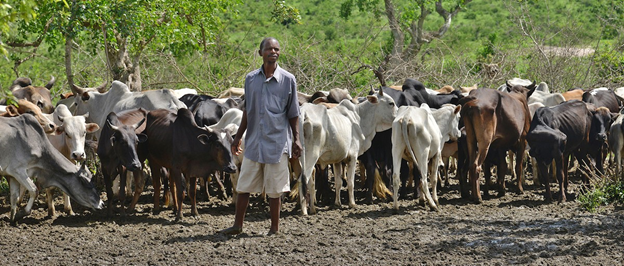
Agriculture is the mainstay of the nation’s economy and almost 80 percent of the population earns their living from the sector. It also contributes up to 85 percent of export earnings.
However, the subsistence and traditional way of farming made the sector vulnerable to climate variation which poses drought and flood to the other extreme.
The livestock subsector also faces similar challenges. Cattle raisers move from place to place for searching forage and water and during extreme weather condition many of their animals meet their death in the wilderness.
In time of hardship, farmers tried their level best to sustain their livelihood by consuming their stored grains but it is only for shorter period; as the result, they will be forced to stretch their hands to take handouts from donors. Such practice has been continued since 1950s.
Now time is changing and farmers began to develop a culture of modern saving system by their credit associations so that they could overcome the penury they may face during drought season. Such approach draws the attention of donors and private financial institutions and they show interest to provide insurance coverage in the form of weather index and so far the practice is undergoing in several parts of the countries and till now thousands of farmers have been benefiting.
Solomon Zegeye is working at the Nyala Insurance Company as a Manager of Micro Finance Department. As to him, his company has long been delivering its financial inclusion duties through the provision of various models of micro insurance with the cooperation of the government, international non-governmental organizations and the World Bank. It is also a pioneer of Agricultural micro Insurance in Ethiopian Market. The company strategically operates on three Insurance Business Areas and among others General Insurance Business, Long-term Insurance and Micro Insurance Business that is Crop, livestock and Life and health.
Poverty is more rampant in the rural part than the urban areas. In Ethiopia 60 percent of the population is living in the high land parts of the country with various agro-ecological zones engaged in sedentary farming. The rest of the population which is 40 percent is living in the law land parts of the country engaged in pastoral and agro-pastoral activities. About 13 million small holder farmers account for 90% of agricultural GDP. Nearly 55% of small holder food producers engaged in one hectare or less.
In the densely populated areas of the central and southern part of the country due to land scarcity farmers yield is declining from time to time and in time of drought, their living is critically hit. Hence, reaching them through financial inclusion scheme helps to withstand the crises.
The company has a strategy to create partnership with stakeholders engaged in rural financial service, small holder agricultural development, agricultural value chains, financial services and digital technology to low-income urban population.
According to Solomon, the provision of micro insurance service is conducted by various models. Livestock insurance products are dictated or determined by agro-climatic conditions and livelihood systems. The other model known as indemnity based livestock insurance that covers risks like disease, illness, accident, calving, windstorm, smoke, electrocution, flood and the bite of a snake. It is also provided for commercial growers and small-holder farmers in highland and agro-pastoral livelihood areas. The index based livestock insurance solely practiced in low-land, arid and desert agro-ecologies Drought insurance extremely vital and it is the significant risk threatening the livelihood of the pastoralists and conducted through Satellite based Index.
For the scheme financial and technical support provided by World Food Program and Product design and pricing done by consultant from United Kingdom and International Livestock Research Institute also took part in it. National Meteorological Agency served as calculation agent regarding interpreting the information collected from satellites.
There are four local insurance companies which carry risks on pool basis with Nyala Insurance taking the technical aid to provide reinsurance protection. Farmers and to pastoralists are required to purchase premium through their saving and credit association but usually up to 100% of it subsidized by the donor-World Food Program. The insurance coverage is provided for long and short rain periods.
If the data received from satellite indicates that there was rain failure, pastoralists or sedentary farmers would be paid costs of purchasing feed, water and drug intervention areas. So far in the regions such as in Beneshalgul Gumuz, Amhara and Southern Nation Nationalities and Peoples’ State totally 6,500 small scale farmers received 50 million Birr because of the crop failure due to drought in 2022. Farmers allocated the money to purchase grain for personal consumption, seeds and agricultural inputs for the next harvest season.
As to Solomon, the areas that have been hit by recurrent drought based on the data brought from satellite in Somali Region in the places known as Adadele, Kebri Dehar and west Elimi 5001 beneficiaries received 70 ,014,000 Birr.
In addition, in Afar region three woredas 3200 pastoralists received 8,809,152 Birr. The money is allocated for purchasing drug to treat their infected cattle by diseases. From time to time the number of beneficiaries also increased but there are also challenges which need remedial actions and among others, lack of technical skills in product design and index based pricing. Short pilot duration of the insuring program and low level financial literacy of beneficiaries also can be mentioned.
As to Slomon, some of the forwarded solutions to address the mentioned shortcomings are scaling up and sustaining micro insurances and to that end there must be collaboration among stakeholders.
Encouraging innovative public private partnership and the major stakeholders, the government, which plays crucial role in poverty alleviation should create enabling environment by formulating legal framework and introducing proclamation helpful for micro insurance development and supporting innovation technologies for premium collection.
In the last two years, both in Somali and Oromya Regions of Borena hundreds of thousands livestock population died due to drought. The natural disaster currently witness is very critical to the government and to the nation at large. To save the remaining cattle, government and non-governmental organizations are trying their level best. Regional governments also provided millions of Birr to the victims.
According to the National Disaster Prevention Authority, the magnitude of drought witnessed frequently is extremely difficult and in which the nation ever had experienced in the last 50 year. The disaster that hit the animal intern affects the livelihood of the pastoral communities. As it is known the pastoral communities mostly resided in the arid zones are often vulnerable to drought and natural calamities and the absence of infrastructure such as roads, piped water and health centers further complicates the matter.
Drought not only put stress on grazing resources but also it poses the outbreak of cattle diseases which are beyond their capacity to withstand the crises. As a result, many animals mate their death at the wilderness. However, due to the due attention paid by the regional and the federal governments, it was possible to save human lives. As it is known the life of the pastoral community depends on finding forage for their animals; as the result, they move place to place in search of grass and water. But when disastrous situation occur all things will be multiplied by zero. Hence, to change the situation to the better striving to bring long lasting solution through transforming their way of life is essential; this can be done by providing them with finance.
BY ABEBE WOLDE GIORGIS
THE ETHIOPIAN HERALD WEDNESDAY 24 JANUARY 2024





